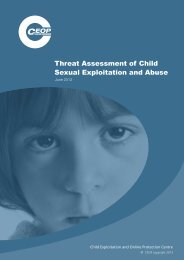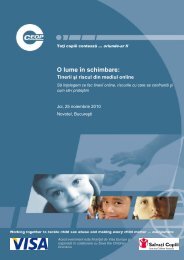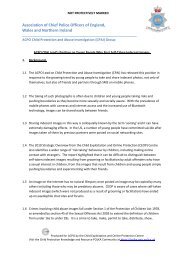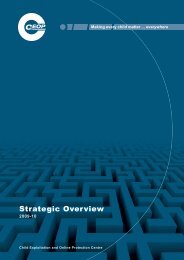Threat Assessment of Child Sexual Exploitation and Abuse - Ceop
Threat Assessment of Child Sexual Exploitation and Abuse - Ceop
Threat Assessment of Child Sexual Exploitation and Abuse - Ceop
Create successful ePaper yourself
Turn your PDF publications into a flip-book with our unique Google optimized e-Paper software.
6<br />
<strong>Threat</strong> <strong>Assessment</strong> <strong>of</strong> <strong>Child</strong> <strong>Sexual</strong> <strong>Exploitation</strong> <strong>and</strong> <strong>Abuse</strong> 2012<br />
Section 2 General Picture <strong>and</strong> Emerging <strong>Threat</strong>s<br />
<strong>Child</strong> sexual exploitation <strong>and</strong> abuse<br />
The most rigorous <strong>and</strong> comprehensive indication <strong>of</strong> the overall prevalence <strong>of</strong> sexual abuse today can be found in a major<br />
study - ‘<strong>Child</strong> <strong>Abuse</strong> <strong>and</strong> Neglect in the UK Today’ 2 which is based on asking a representative sample <strong>of</strong> UK children <strong>and</strong><br />
young people to reflect on their experiences <strong>of</strong> abuse during childhood.<br />
In comparison to their earlier study in 2000, the findings suggest a decline in serious forms <strong>of</strong> contact sexual abuse. In<br />
addition, the level <strong>of</strong> coerced sexual acts against under 16 year olds declined from a 6.8% national prevalence rate in 1998<br />
to 5% in 2009. These findings are consistent with other data.<br />
Additional research has shown a consensus in public perception which identifies ‘stranger danger’ as the most significant<br />
risk in respect <strong>of</strong> sexual <strong>of</strong>fending against children. However, empirical evidence shows that approximately 80% <strong>of</strong> sexual<br />
<strong>of</strong>fences against children are committed within the family or by persons known to the child or children, <strong>of</strong>ten in positions <strong>of</strong><br />
trust. Similarly, approximately 80% <strong>of</strong> sexual <strong>of</strong>fences against children occur in the home <strong>of</strong> either the <strong>of</strong>fender or the victim.<br />
This assessment acknowledges that child sexual exploitation <strong>and</strong> abuse takes place in both online <strong>and</strong> <strong>of</strong>fline environments<br />
<strong>and</strong> that the distinction is in many ways artificial to children <strong>and</strong> young people in 2012.<br />
Self generated indecent imagery<br />
CEOP has seen a marked increase in the number <strong>of</strong> reports where young teenagers appear to have taken still or video<br />
indecent imagery <strong>of</strong> themselves which is then shared online. For the purposes <strong>of</strong> this assessment such material is referred to<br />
by the generic term, ‘self generated indecent imagery’ (SGII). It is worth noting that the distribution methods for SGII can vary<br />
widely. As such, the term encompasses a range <strong>of</strong> behaviours <strong>and</strong> accompanying levels <strong>of</strong> risk.<br />
During 2011/12, CEOP found that SGII is distributed by its author in the following ways (in order <strong>of</strong> prevalence):<br />
8 live one to one video chat on websites;<br />
8 video chat via instant messaging applications;<br />
8 files sent by email to another person;<br />
8 files uploaded to public video hosting websites;<br />
8 files being sent as attachments during online chat sessions; <strong>and</strong><br />
8 files used as pr<strong>of</strong>ile images or posted on social networking websites.<br />
In contrast to the findings <strong>of</strong> the previous TACSEA, the picture in 2012 shows that a vast majority <strong>of</strong> SGII is being freely<br />
produced <strong>and</strong> uploaded to the internet by children without external influence, coercion or threat from adults or others.<br />
SGII are taken for a variety <strong>of</strong> reasons within consensual relationships between young people. These include a private image<br />
taken for a boyfriend or girlfriend or images taken to be used as online pr<strong>of</strong>ile pictures. Often these images are subsequently<br />
posted online or distributed by the person for whom they were intended as a joke, after an argument or once the relationship<br />
has ended. It cannot be discounted, however, that the exchange <strong>of</strong> SGII, whilst it may have been willingly produced by<br />
a young person, can indicate an underlying vulnerability or behavioural concern.<br />
2 NSPCC, 2011.











